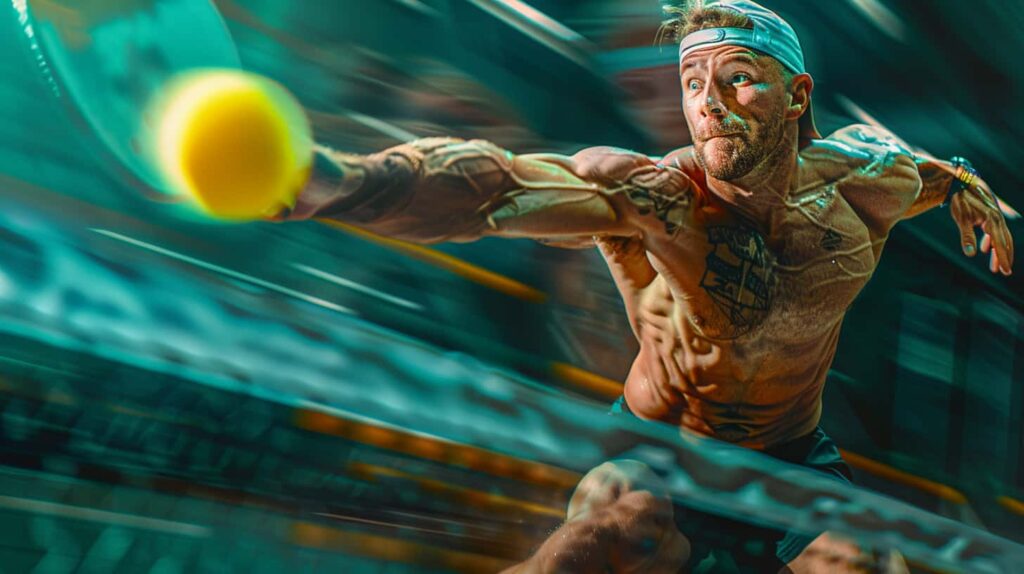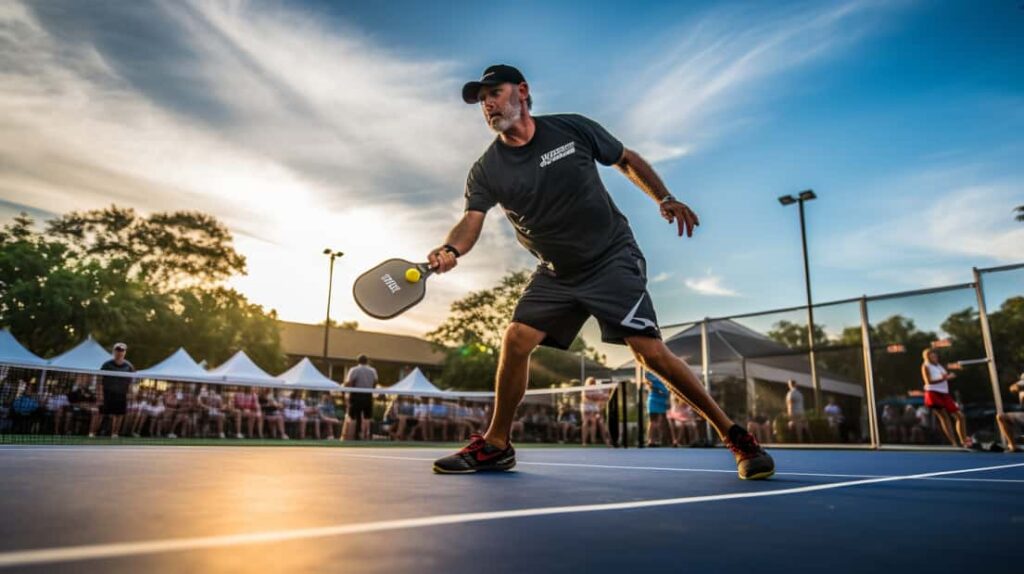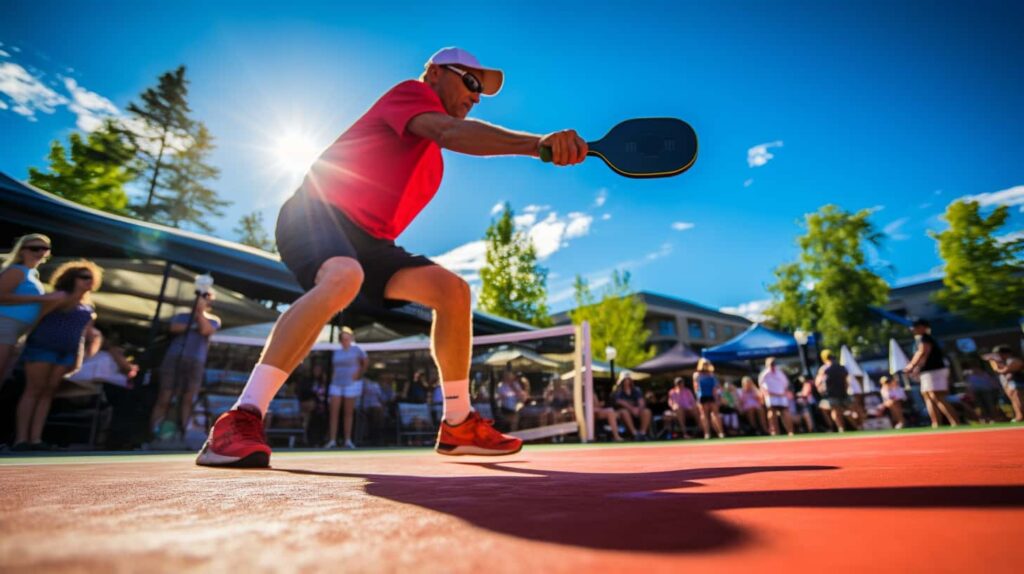Have you ever wondered what muscle pickleball works? It’s not just a fun game; it’s a full-body workout in disguise! From your legs doing quick sprints to your arms swinging that paddle, pickleball gets you moving every which way. This article dives into which muscles work the most extensively while serving and volleying. So, if you’re curious about how pickleball is secretly shaping you up, stick around to discover the muscle magic behind the sport!
What Muscles Does Pickleball Work?

Now, explore these muscles further and understand how they contribute to your prowess on the court.
Upper body: arms, shoulders, chest
Pickleball gives your upper body a great workout, especially your arms, shoulders, and chest. Each time you hit the ball, these muscles spring into action. Your deltoids do much work as they help power through each shot.
The rotator cuff in your shoulder gets stronger with every swing too.
Specific exercises can boost your game even more. Try the TRX chest press to make those pushing movements on the court feel easier. This exercise works not just your pectoral muscles but also builds endurance in your arms and shoulders.
It helps keep everything stable around the shoulder blades while you play hard during pickleball matches.

Core muscles: abs, obliques, lower back
Having strong core muscles is like having a powerhouse for your pickleball game. These muscles make up your abs, obliques, and lower back. They help you maintain balance and posture, leading to more precise shots on the court.
Engage these muscles whenever you reach for a shot or twist to return a serve.
Focus on exercises that strengthen these vital areas to keep your core in top shape for play. Planks, sit-ups, and twists build muscle and protect against lower back pain—a common concern among many athletes.
A solid core enhances stability and control throughout your entire body. It’s crucial for powering through an intense game or mastering that tricky backhand swing.
Lower body: legs, glutes, hips

Your legs get a fantastic workout playing pickleball. Quick steps and lunges work your quadriceps, which sit at the front of your thighs. This helps you sprint and change direction fast on the court.
Your glutes and hamstrings also get in on the action—they power up your moves as you reach for that low volley or lunge for a high serve.
Moving around the court means your calves are constantly engaging, helping to push you forward into that next shot. Playing pickleball will have your hips working hard too; they’re key for the essential side-to-side movements in the game.
Every serve, return, and rally tone these lower body muscles, making them stronger with each match.
Preparing Your Body for Pickleball
Engaging in pickleball means preparing your body for the sport’s unique demands, ensuring you can enjoy each game while minimizing the risk of injury. This preparation involves targeted exercises and routines that amplify strength, flexibility, and endurance to meet the fast-paced nature of pickleball play.
Warm-up exercises
Warming up your body before a pickleball game is key to playing well and staying safe. Dynamic stretches get your blood flowing and muscles ready for the action.
- Rotations – Stand with feet shoulder-width apart, hold your paddle with both hands in front of you, and rotate your upper body from side to side. This gets your torso moving and preps you for those quick turns during the game.
- Shoulder Circles – Lift your arms out to the sides at shoulder height. Move them in small circles, gradually increasing size. This exercise warms up your shoulder muscles, essential for powerful serves.
- Neck Stretches – Gently tilt your head from one side to the other. Then, move it in a circular motion clockwise and counter-clockwise. This helps reduce tension in the neck area.
- Cat-Cow Stretch – Position yourself on all fours on the court. Arch your back up, tucking your chin into your chest (Cat), then lower your belly down as you lift your head (Cow). This stretch is great for loosening the back muscles used in pickleball.
Proper stretching
Proper stretching is key to playing pickleball well. It preps your muscles and joints, making you less likely to get hurt.
- Dynamic stretches raise blood flow, and help muscles get ready for action.
- Begin with leg swings to loosen up your hips and prepare them for quick side moves.
- Lunges are great for warming up your legs and glutes, which is crucial for those low shots.
- Arm circles prepare your shoulders, making hitting the ball easier and safer.
- Shoulder stretches protect from injuries like rotator cuff damage, which can sideline a player.
- Hamstring stretches keep the back of your legs limber, helping you sprint to the net without a pull or strain.
- Don’t forget quad stretches; they make sure the fronts of your thighs are prepared to squat and lunge during the game.
Importance of prehab
Prehab exercises are key to keeping your body ready for pickleball. They improve muscle flexibility, which is crucial for those quick, smooth moves during a game. Think of it as setting the stage – you’re getting your muscles loosened up and raring to go before you even step on the court.
This preparation helps prevent injuries that could come from sudden movements.
With prehab, players target their quads uniquely, unlike lunges or squats. Focusing on these exercises before playing enhances performance and keeps your leg muscles strong and flexible.
Stronger legs mean better side-to-side motion – essential when facing fast-paced pickleball action!
Ways to Enhance Your Pickleball Workout
To take your pickleball game to the next level and amplify the fitness benefits, consider integrating dynamic routines that complement the sport’s unique physical demands—stay tuned for innovative strategies that will supercharge your performance on the court.
Incorporating resistance bands
Using resistance bands can take your pickleball game to the next level. They help build and engage muscles that are important for pickleball.
- Add resistance band exercises to your routine to strengthen your stabilizer muscles. These muscles keep you balanced and stable on the court.
- Resistance bands increase your muscle and joint mobility. This makes it easier for you to move quickly during a game.
- Include bicep curls with bands for stronger arm muscles. Strong arms improve your paddle swings.
- Use bands for chest presses to work on chest muscles. A strong chest helps with powerful serves.
- Wrap a band around your legs for side steps. This exercise strengthens hip and glute muscles, which are key for lateral movement.
- Perform resistance band pull-apart to target the shoulders and upper back. These areas are crucial in controlling the paddle.
- Try band-assisted squats to engage leg muscles fully, as they provide the foundation for quick footwork.
- Invest time in exercising rotator cuff muscles with bands before playing. This can protect against shoulder injuries common in racquet sports.
- Practice resisted lunges to boost lower body strength, which is essential for moving swiftly across the court.
- Finish with core workouts using bands, like twists or crunches, to enhance stability when reaching for shots.
Adding cardio bursts
Pickleball gets even better when you add cardio bursts to your game. These quick, intense exercises help boost your heart rate and make the match more challenging.
- Jog in place for 30 seconds between points to keep your muscles warm and ready.
- Perform jumping jacks during a 1 – minute break to elevate your heart rate further, improving cardiovascular health.
- Include high-knee lifts as you move around the court, enhancing agility and stamina.
- Add short sprints from one side of the court to the other to build speed and quickness.
- Engage in on-the-spot butt kicks to activate leg muscles and increase blood flow.
- Use lateral shuffles across the court during play stoppages, which target hip muscles and improve lateral movement.
The Health Benefits of Playing Pickleball
Engaging in pickleball offers a spectrum of health advantages that extend far beyond physical activity, touching on mental acuity and social connectivity—discover how this multifaceted sport can be a game-changer for your overall well-being.
Also Read: Top 10 Social Benefits Of Playing Pickleball
Increased activity levels for older adults
Pickleball gets older adults moving and improves their heart health. It pushes them into moderate to vigorous exercise zones. This activity boosts their health, reduces stress, and sharpens their minds.
Older players often see a jump in their daily activity because pickleball is fun and social. They move more without thinking about it as they chase the ball, laugh with friends, and enjoy the game.
It’s not just a workout; it’s joy wrapped up in a sport for seniors. Pickleball makes staying active easy for them. Regular games can lead to a stronger body and a happier life. Their muscles get worked out from serving to volleying.
Discover more about how this sport can enhance senior living in our article on the Benefits of Playing Pickleball for Seniors
Improved mental health
Hitting the court for a game of pickleball does more than just work your muscles—it’s also a boost to your mind. As you play, stress melts away and your brain releases endorphins.
These are chemicals that make you feel good and can help fight depression. The sport isn’t just about staying active; it also sharpens your focus and boosts overall cognition.
Regular games can lead to lower blood pressure and better heart health. This kind of improvement is great for mental well-being. Imagine feeling calmer after a few rounds with friends, thanks to pickleball’s unique mix of physical exercise and social interaction! It’s an excellent way to keep the body and mind in shape.
Is pickleball good for weight loss?
Pickleball gets your body moving and can lead to weight loss. This fun sport makes you work up a sweat. You might not notice how hard your body is working because the game is so exciting.
But as you play, you’re burning calories fast! A person who weighs 150 pounds can burn around 250 calories from just half an hour of playing.
Compare this to walking; pickleball requires more energy and helps shed pounds quicker. Regular games mean steady calorie burning, which increases over time for great weight-loss results.
The best part? You have fun while losing weight without feeling like it’s a workout chore!
Does pickleball build muscle?
Yes, pickleball builds muscle. Their muscles work hard as players hit the ball, lunge for shots, and sprint across the court. This activity targets all the major muscle groups. The forearms, biceps, and triceps get a workout from swinging the paddle.
Legs power quick moves and provide balance during play.
Playing pickleball also engages your core, which includes abs and lower back muscles. These muscles help with stability as you move in different directions. Pickleball is not just fun; it’s a full-body workout that strengthens bones.
Your body responds to this exercise by strengthening muscles over time. So grab your paddle – pickleball can help you build lean muscle while enjoying every game!
Why does pickleball hurt my back?
Pickleball puts strain on your lower back muscles and ligaments. This happens during fast moves and quick turns in the game. Like abs and obliques, your core muscles work hard to stabilize you.
If they’re not strong enough, your lower back takes the extra stress.
Playing pickleball also uses your leg muscles a lot. The quads, hamstrings, and calf muscles power your movements on the court. If these aren’t well-conditioned or stretched out, it can lead to pain in your back.
Strengthening exercises for the core help protect the lower back by providing better stability around your pelvis.
Nutrition Tips for Pickleball Players
We’re serving up the best nutrition advice to keep your energy levels high during every match. But wait, there’s more! If you’re looking for the perfect bite between games, check out our post on 15 Healthy Snacks for the Pickleball Tournament. These snack ideas might just be the boost you need to ace your game!
Before, during, and after workout meals
Eating right fuels your pickleball game and recovery. Your food choices can greatly affect how you play and feel.
- Before playing pickleball, eat a carbohydrate meal to boost your energy levels. Think of options like oatmeal with fruits or whole-grain toast with peanut butter.
- Include proteins to aid muscle repair; a smoothie with Greek yogurt or scrambled eggs can be a good choice.
- Keep fats moderate before the game; too much can slow digestion. Avocado on toast is a great option that provides healthy fats.
- During the game, stay hydrated with water or an electrolyte drink. This helps keep your energy up and prevents cramps.
- Snack on small bites if it’s a long match. Bananas or granola bars are easy to digest and offer quick fuel.
- After the game, replenish with a mix of carbs and protein. A turkey sandwich on whole grain bread or quinoa salad can help repair muscles.
- Eating every few hours aids recovery, so have snacks like yogurt or nuts ready post-match.
- Pick foods that support both physical performance and mental focus, as suggested in the important facts above.
- Following these nutritional tips supports health and boosts your pickleball performance.
Importance of staying hydrated
Drinking enough water is a big deal for pickleball players. Your body needs it to keep cool and give you energy as you move around the court. As you play, staying hydrated helps your brain stay sharp, so you can make quick decisions and keep your reflexes fast.
Without enough water, your muscles might tire more quickly, messing up your game.
It’s also smart to sip on sports drinks with electrolytes, especially during long matches or hot days. These drinks can replace what you sweat out and help stop heat illness from sneaking up on you.
Keep that water bottle filled up—your body will thank you by playing its best pickleball every time!
Also Read: What should you eat before playing pickleball?
Conclusion
Playing pickleball is fun and works out your whole body. Your arms, legs, and core all get stronger. Plus, you’ll move faster and feel better in your day-to-day life. Remember to eat right, stay hydrated, and keep those muscles moving – on and off the court! Pickleball isn’t just a game; it’s a way to build health for everyone.
FAQs
- What are the main muscles used in pickleball?
Playing pickleball works with various major muscle groups, including those in your legs, core, and arms. It’s a full-body workout that gets many muscles moving!
- How does playing pickleball benefit my physical fitness?
Pickleball is an aerobic sport that provides mental and physical benefits, boosting overall health. It’s a fun way to improve muscle strength, flexibility, and cardiovascular health.
- Is pickleball easy for beginners, and is it a good workout?
Absolutely! Pickleball is beginner-friendly and simple to pick up. Plus, it’s an excellent workout – you’ll have so much fun that you won’t notice how hard your body works.
- Can exercises help me play better at pickleball?
Sure can! Exercises such as squats strengthen key muscles crucial for quick movements in doubles or singles games—making you ready to hit that ball with agility!
- Are there any risks of injuries while playing pickleball?
Like any sport requiring swift actions, there’s some risk of injury—but don’t worry! Focusing on proper technique and warming up can help keep those pesky injuries away.
- What makes pickleball more than just exercise?
Pickleball isn’t just about getting fit—it’s also social and engaging! You can enjoy connecting with others while giving essential muscles a great workout.
Recent Posts
Picking the perfect pickleball team name is a big deal. Whether you're all about having a good laugh with a funny moniker, aiming to be known as the best pickleball team in the tournament, or just...
Struggling to level up your pickleball game? The third shot drop is a make-or-break skill in this fast-growing sport. Our blog will guide you through the ins and outs of hitting that perfect,...
